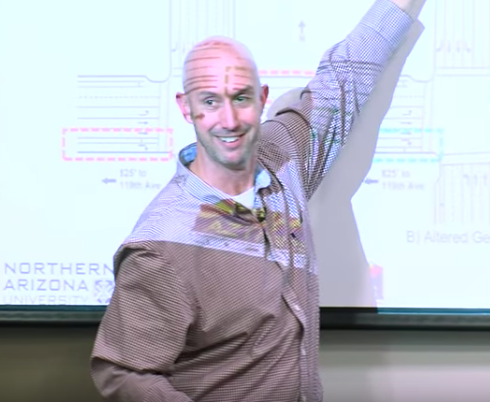News | NAU's Edward Smaglik Reaches Avid Bicyclists by Addressing Bicycle-Vehicle Conflicts with Alternate Signal Control Strategies
Stop the VideoNews

METRANS UTC
NAU's Edward Smaglik Reaches Avid Bicyclists by Addressing Bicycle-Vehicle Conflicts with Alternate Signal Control Strategies
Saturday, March 2, 2019
by By: Susan Gonzalez, M.S. Transportation Engineering, USC 2020
On February 20, 2019, Dr. Edward Smaglik of Northern Arizona University presented results from a NITC-funded collaborative research project which investigated bicycle-vehicle safety at urban intersections and aimed to address conflicts through signal timing treatments while also maintaining efficiency for all user groups within the intersection.

As bicycling rises in popularity and communities start investing more in bicycle infrastructure, transportation professionals must address the inevitable conflicts that occur when multiple modes of transportation converge in the same space. Additional care must be taken to protect cyclists during these conflicts. Predictably, bicycle-vehicle collisions occur often at intersections. A common incident that is observed at intersections is a “right-hook” which is when a through bicyclist collides with a vehicle that is turning right.
Common ways to improve bicycle safety are roadway design treatments, and studies on the use of signal timing treatments have been limited. In the specific case of a “right-hook”, releasing a right-turning vehicle at a different time can enhance safety for bicyclists (and pedestrians) making a through movement on the same side of the street. The study proposed various signal timing treatments like exclusive phasing (separating vehicle and bicycle into different phases), leading bicycle intervals or LBI (restricting traffic for a few seconds at the beginning of a phase), and split-LBI (restricting right turns for a few seconds at the beginning of a phase, with immediate and concurrent green for bikes/pedestrians and through vehicles). If signal phasing can be pictured as pieces of a pie, one can see that the proposed treatments are listed in order of least to most efficient for all modes meeting at an intersection. Exclusive phasing would increase delays for all users since bicycle-only phases would either increase cycle length or reduce time for other critical movements. Split-LBI is a good middle-ground solution that introduces minimal lost time to right-turners only.
The study evaluated various signal timing treatments using video-based and microsimulation analyses. For the video-based analysis, footage was collected from intersections in New York City, NY, Portland, OR, and Phoenix, AZ. For the microsimulation, the research team used VISSIM to perform a software-in-the-loop (SITL) simulation based on an Econolite ASC/3 signal controller.

The results of the presented study recommend mixing zones or traditional concurrent signal timing for areas with low volumes bicycles and turning vehicles. Medium-high-volume areas would benefit from LBI or split-LBI treatments, but collision risks still exist after the release of turning vehicles during the stale green portion of a phase. Exclusive bike phases are recommended at high-volume intersections to minimize or eliminate windows of conflict, but the greatest delays are experienced with this type of signal treatment.
I was excited to attend this seminar having been a long-time cyclist through the busiest parts of Portland and Los Angeles. After crossed hundreds of intersections, I gained a good sense of signal phasing around LA. I recall making a habit of stopping about ten feet before the pedestrian crosswalk at a signalized intersection whenever I hit a red light, observing the signals on the intersecting street for the yellow light, and giving myself a head start to build speed by the time I entered the intersection. I did this to get through the intersection faster to avoid inconveniencing both myself and right-turners (though I am not recommending this). The presentation of bike-specific signal treatments reminded me of this strategy, but a lot safer. It would have been much more reassuring for me to have the supporting framework of signal timing during my rides. As I get deeper into my studies and the field, I have a greater appreciation for the efforts being made to improve safety for one of the most vulnerable groups sharing the road. As a driver also, the additional effort in the study to evaluate delay for all user groups was also great to see. I hope to see innovative signal timing control strategies being put into practice to encourage more individuals to consider cycling.
Check out Edward Smaglik’s full presentation here: https://www.youtube.com/watch?v=KBJNQWe0EIk&feature=youtu.be.
About the Speaker:
Dr. Edward J. Smaglik, P.E., is a Professor at Northern Arizona University (NAU), in Flagstaff, AZ. The Director of AZTrans: The Arizona Laboratory for Applied Transportation Research, Dr. Smaglik has over 11 years of academic research and teaching experience. Dr. Smaglik has served as the PI on transportation-related projects over a wide range of topics in this discipline.
About the Author:
Susan Huang Gonzalez is Master of Transportation Engineering student in the USC Sonny Astani Department of Civil and Environmental Engineering with plans to graduate in 2020. Susan grew up in Portland, Oregon but has been a long-time resident of LA. She developed an interest in the field of transportation after years of commuting around Portland and LA by bike and public transit. She looks forward to the challenges and rewards of working in one of the most congested regions in the world.
Reference:
Kothuri, S., Kading, A., Schrope, A., White, K., Smaglik, E., Aguilar, C., Gil, W. Addressing Bicycle-Vehicle Conflicts with Alternate Signal Control Strategies. NITC-RR-897. Portland, OR: Transportation Research and Education Center (TREC), 2018. https://dx.doi.org/10.15760/trec.194
News Archive
- December (1)
- November (6)
- October (4)
- September (2)
- August (3)
- July (4)
- June (3)
- May (7)
- April (8)
- March (11)
- February (8)
- January (7)
- December (7)
- November (8)
- October (11)
- September (11)
- August (4)
- July (10)
- June (9)
- May (2)
- April (12)
- March (8)
- February (7)
- January (11)
- December (11)
- November (5)
- October (16)
- September (7)
- August (5)
- July (13)
- June (5)
- May (5)
- April (7)
- March (5)
- February (3)
- January (4)
- December (4)
- November (5)
- October (5)
- September (4)
- August (4)
- July (6)
- June (8)
- May (4)
- April (6)
- March (6)
- February (7)
- January (7)
- December (8)
- November (8)
- October (8)
- September (15)
- August (5)
- July (6)
- June (7)
- May (5)
- April (8)
- March (7)
- February (10)
- January (12)















